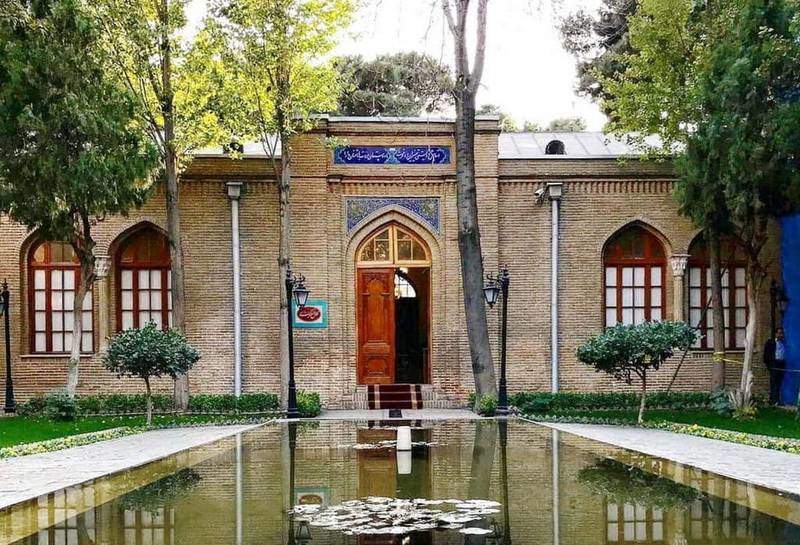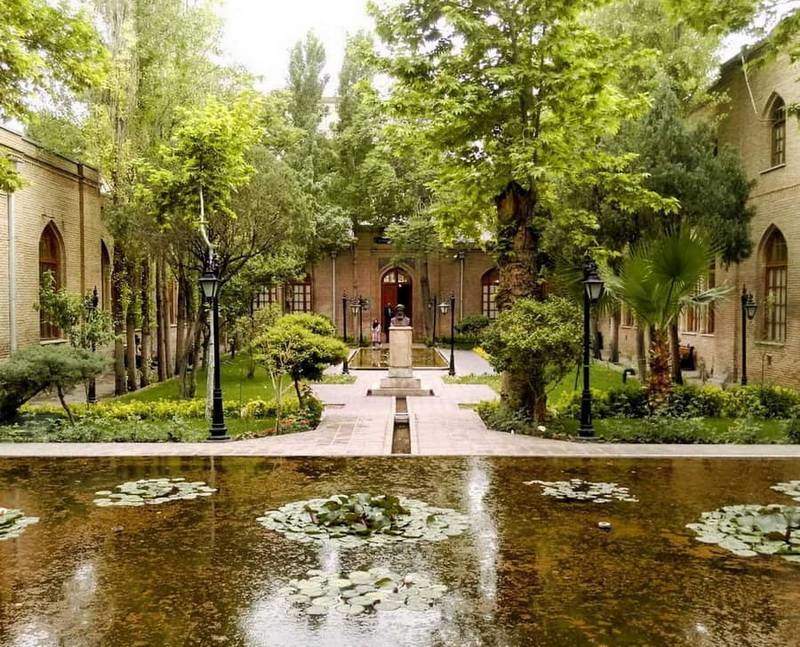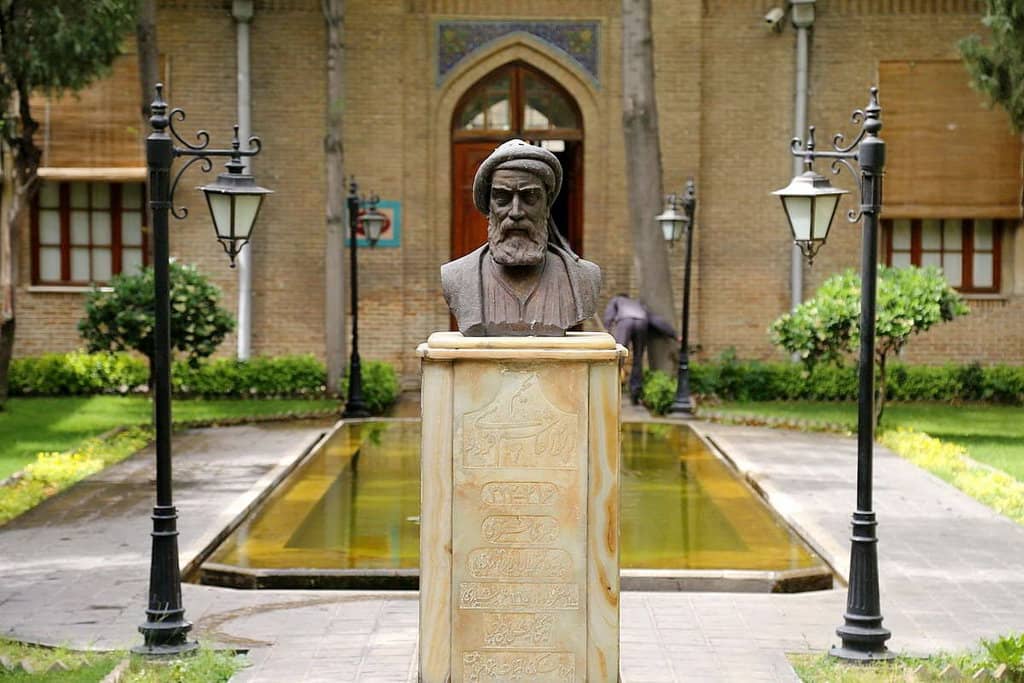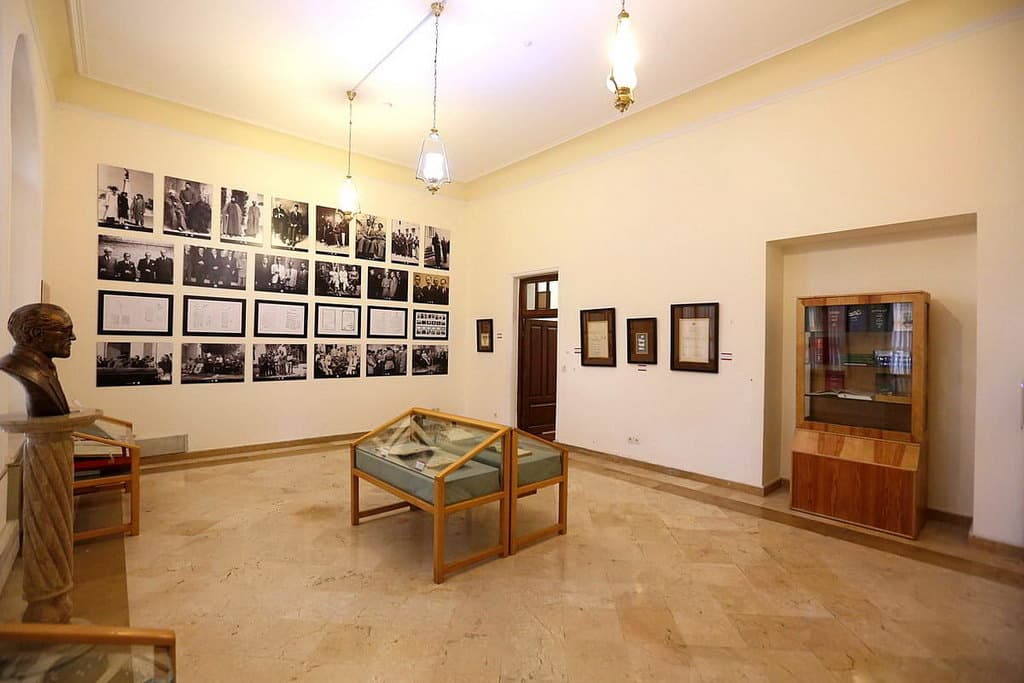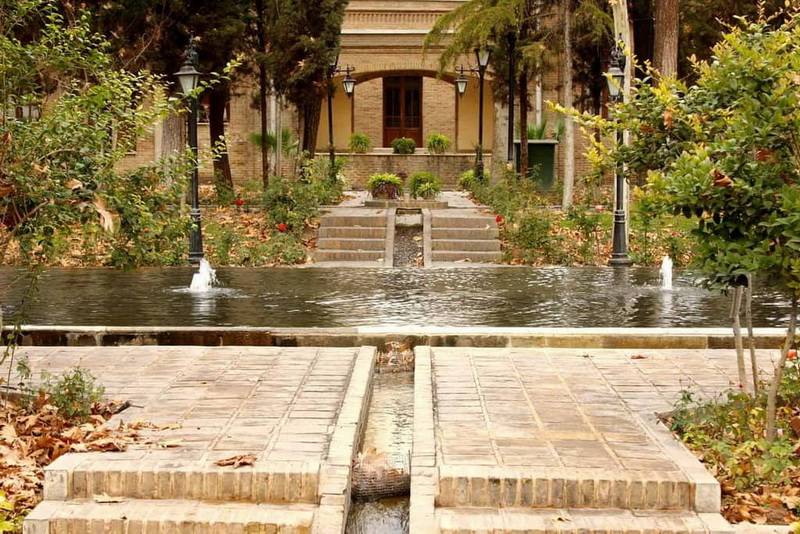Negarestan Museum Garden, Kamal Al-Molk Museum and their collections
-Taste of Ferdousi
This building was built in style "Kolā'e farhangi"(Lett: foreign hat) and consists of two splendid palaces named Delgoshā and Tālār-e Qalamdān. The Delgoshā palace o Howz Khaneh, is the most famous building in the garden, it is located in the center of it in the form of a two-story octagonal pavilion.
The lower floor of this building was the building howz khāneh and the upper one the Delgoshā palace adorned with beautiful paintings like the French group and the Saf-e Salām (lit: greeting line) by Fath Ali Shāh. The Tālār-e Qalamdān was located in the north and east facade of the Negarestān palace and its interior was embellished with murals such as that of Fath Ali Shāh and his sons and also images of women dancing and singing of which now there is no trace left.
Also the palace Negarestān or Diwankhāneh, the most important building of the complex, was located south of the Delgoshā palace, in the part of theandaruni (internal, reserved for women) and consisted of the large Salām hall and some rooms and corridors adorned with paintings.
The Salam Hall, which was also called the "royal salon" or "royal hall", was located in the central environment of the palace and was used for reception in official ceremonies. Therefore on its walls beautiful images of the greeting ceremony of Fath Ali Shāh were impressed. These paintings, made up of 118 full-length paintings, showed the image of Fath Ali sitting on the throne together with his 12 sons and six escorts on the north facade and the painting of the aristocrats, statesmen and ambassadors on the other two sides of the lounge area.
Unfortunately, these pictorial scenes have been lost over time and the only thing left is the numerous remakes and copies on canvas made by various artists over different periods. This garden has 64 rooms, four lounges, a library with 4 halls and 600 meters of square footage. In all the interior spaces of the buildings, the halls are adorned with mirror work, silver decorations, gold designs and precious chandeliers and the walls of the rooms are embellished with works of art.
This palace-garden that today belongs to the University of Tehrān, has witnessed numerous historical-political events. This complex was once used by various cultural-educational and research institutes, and specialization schools and a library were created here.
Unfortunately, over time the Negārestān garden has suffered extensive damage and many parts of it have disappeared. Over more than half a century, a large number of literary and artistic personalities of the country such as: Malek Al-Sha'rāye Bahār, Kāzem Asār, Ali Akbar Dekhodā, Badi'Al-Zamān, Ali Naghi Vaziri, Jalāladdin Hamāii, Sa'id Nafisi, Mahmoud Hesabi, Ebrāhim PourDavood, Gholāmhossein Sadiqi, Parviz Khanlari, Mohammad Mo'ayyen, Mohammad Ebrāhim Bāstāni Pārizi, Ali Mohammad Kārdān etc. have studied and taught in this historical complex.
This museum garden includes the following collections:
The precious bust of Ferdousi, famous poet and author of the Shāhnāmeh is located at the beginning of the entrance to the garden of the Negārestān museum. It is said that to create it in the year 1313 of the solar Hegira there were great parties to pay homage to the Iranian poet.
A group of Iranian scholarship students, about 410, decided in France in the form of group work and at common expense, to commission the creation of a suitable bust of Ferdousi to the famous French sculptor Monsier Lorenzi who did not have a precise mental image of the face. by Ferdousi. He himself told the Iranian students to read aloud, as far as possible, some of his artistic works so that he could understand a better image of the poet.
Students every day read him parts of the Shāhnāmeh until he managed to create this bust at the expense of the students themselves. The difference of this statue, which in the year 1315 of the solar Hegira was transferred to Iran and placed here, with the others of Ferdousi is that the French sculptor did not have an image of the poet and created it by listening to the poems of the Shāhnāmeh.
-Museum of the school of Kamāl ol-Molk
Professor Mohammad Ghaffāri known as Kamāl ol-Molk, is considered among the most distinguished faces of Iranian art. In the year 1290 of the solar Hegira he founded the school Sanāyeh Mostazrafeh, the first school and University of Iranian art in the garden Negārestān which has exerted a great influence on the rebirth and the spread of arts such as painting, sculpture and the overcoming of the traditional art to reach the modern one.
In this museum that was opened in the year 1392, the school of Kamal-ol-molk and painting of Tehrān was examined and his works and those of two generations of his pupils were publicly exhibited; it is 130 examples of paintings by Kamāl-ol-Molk and almost 40 of his students and well-known Iranian artists such as: Abulhassan Sadighi, Ārshāk, Eskandar Mostaghani, Esmail Ashtiāni, Ja'far Petgar, Jamshid Amini etc.
Next to the paintings of Kamāl-ol-molk works have been exhibited as old photographs of the students and professors of the Sanāyeh Mostazrafeh school and of the Negārestān garden and ancient small and large miniatures, regulations and hand-written school.
-Collection of the anthropological miniatures statues of Jahāngir Arjmand
Professor Jahāngir Arjmand is among the activists in the field of art in the design and construction of miniature statues that in the year XEUMX of the solar Hegira donated part of his works to the museum garden Negārestān. This precious collection demonstrates Iran's cultural, political and social antiquity.
For the realization of all these sculptures the polystyrene was used, the wool of sheep of natural color, and in some cases the human hair and the clothes, the shoes and the hats were sewn by hand. To make the objects around the statues the polystyrene, the paper, the cardboard, the wood and small objects to throw away have been used.
-Collection of miniatures and inlay on the skin of the master Ali Asfarjāni
Collection of paintings by Ali Asfarjāni: this master has been counted among the most representative artists of the country in the field of manual and national arts and has created numerous works including miniatures and inlay on leather. In the salon of the collection of his paintings, in the special section that contains his works, 18 miniatures, the technique of burning the inlay are among the most significant and admirable works donated by this Iranian master.
The images of these works are usually based on poems and classical Iranian literature or on religious stories and stories.
-Collection and salon of Mahmud Ruh Alāmini
Ethnographic collection: most of the photos or rather of the visual masterpieces present in this collection of the salon, are all the result of the talent and creative thought of Dr. Mahmud Ruh Alāmini. He was born in an area called Kuh Benān in the Kermān region and graduated from the faculty of literature of the University of Tehrān. The collection of photographs (from searching for water to obtaining bread), is one of the unparalleled photographic collections where Ruh Alāmini in the best possible way has transferred into images the effort of the Iranian peasants in the phases of sowing and harvesting they led to the preparation of bread for a large number of people.
This collection of artistic photographs testifies to the thought and effort of a few millennia of the inhabitants of this country to obtain bread. The digging (excavation of the culvert), attention to the series of wells, the importance of the appearance of water in the life of the village, the image of the pool, the method of water distribution, the excavation of the earth to be worked , the spreading of fertilizer and water, plowing, sowing, weeding, attention to the product, harvest, division of the seed from the stem, cleaning, weighing and division of the grain, the production of flour, baking bread and finally eating it are among the phases of traditional agriculture which, shown through the image, made this exhibition possible.
This collection of photographs in the 1390 year was donated by the artist's wife to the Negārestān garden.
-Collection of Malek Al-Sha'rāye Bahār
Mohammad Taghi Bahār known as Malek Al-Sha'rāye Bahār, is a poet, songwriter, scholar, professor of the University of Tehrān, journalist and influential politician of contemporary Iranian history. The collection of Mohammad Taghi Bahār, which was inaugurated in the year 1394 of the Hegira solar, is a collection of important moments of the period of youth and its mature age which includes: handwritten, digital documents, a part of precious books and a bronze bust and everything was donated by his daughter to the Negārestān museum garden.
-Saf-e salām by Fath Ali Shāh
The greeting was an official meeting in the presence of the Shāh during which the ministers and those who held a position presented to the Shāh an account of the affairs of the state and sometimes even the princes were obliged to take part in this ceremony.
At the moment of greeting all those present stood in absolute silence and lined up in front of the Shāh; among them, anyone who was older or held a more important position was closer to the Shāh and the latter, seated on the royal throne, received their greeting.
Considering what has been said, the paintings of the Saf-e salām they were portrayed in symmetrical combinations and with a grandiose demonstration of power, mostly for the purpose of demonstrating royal enthusiasm, the greatness of the realm, the influence of power and the importance of this sovereignty in the minds of the people-all inside that outside of the country, of which we have examples besides the garden Negārestān, in the Salimānieh palace of Karaj, in the royal palace of Qom, in the palace Nezāmie of Tehrān and also-in the form of a painting-in the Niāvaran palace and in some other collection and art gallery.
The collection of murals of the Saf-e Salām by Fath Ali Shāh which includes 54 separate paintings, after ups and downs and numerous displacements, in the year 1394 was transferred to the Negārestān garden and in the context of a three-sided structure - in the same previous form - it was placed on the three facades of the Foruzānfar salon of this building.
This 2,15 × 20 meter mural painting which was drawn with the technique of color and oil on a stucco base, depicts the theme of the greeting queue to the Shāh and its political and epic sense. The importance of this work, apart from the artistic technique and the spectacular dimensions, lies in its historical and political aspect, as all the children and grandchildren of Fath Ali Shāh at that time - in which each of the different Iranian ethnic groups had a political position and governmental- they were depicted with a similar image, a particular dress, citing the name of each and in order of age and position.
-Salone Monir Farmānfarmāyān
Monir Shāhrudi Farmānfarmāyān, is a painter and collector of popular art and the only artist in the last 40 years to have used the combination of mirrors, geometric shapes, motifs and the technique of inverted glass painting to create her modern works. His particular style combines compositions of mirrors, khātam (ancient Persian technique of inlay), Islamic geometries and architectural drawings.
In the permanent salon of Monir Farmānfarmāyān there is an exhibition that includes 51 valuable works donated by this painter to the collection of the Negārestān museum garden. These, due to their particular style which is a kind of geometric abstraction, are considered a union of traditional Islamic and modern designs.
Moreover, the combination of traditional glass mosaics and Islamic geometric models could, with a modern artistic understanding, bring particular value to these works.
This exhibition was inaugurated in the year 1396 in the presence of Monir Shāhrudi Farmānfarmāyān, managers, a group of artists and art lovers and has been publicly exhibited.
- Room of the Negārestān museum tiles
The art of tiling in Iran has been used since ancient times as an important element in architecture for the decoration of buildings. The tiling of the Qajar period was one of the most dynamic arts of that era, giving the architectural buildings a particular appearance.
Tiling was used in the main building of the Negārestān palace or garden and its other buildings for decoration.
In the Negārestān garden room dedicated to this art there is a varied collection of decorative architectural tiles and ornaments that has been preserved over the centuries and mostly belonged to the 13-14 centuries of the lunar Hegira. These works are often part of walls, walls and portals and have been created with drawings of plants with enamelled painting techniques, inlaid and with relief molds.
-Coffee Tehroon
The Tehroon Café with the style of the Hāfez mausoleum in Shirāz, is the only restaurant in the Negārestān garden. In this place you can sit at tables and antique chairs that were once considered the most modern objects and you can enjoy a cup of coffee or other natural spirits in company; a place where mostly traditional ancient music is played which is in harmony with the ambience of the Café.



